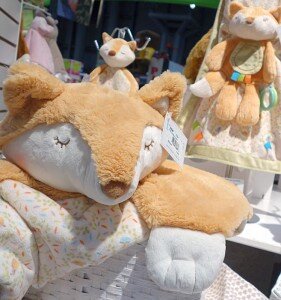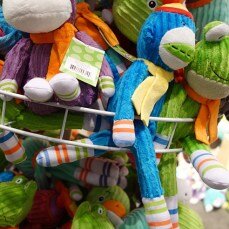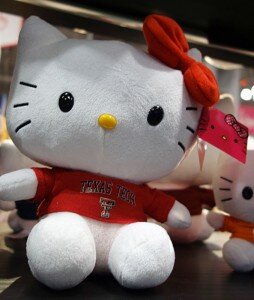Party Product Trends: Birmingham Spring Fair
Lorem ipsum dolor sit amet, consectetur adipiscing elit, sed do eiusmod tempor incididunt ut labore et dolore magna aliqua. Amet aliquam id diam maecenas ultricies mi eget mauris.
The Trend Curve team has gone from one trade show to another since the year began. Today, Leigh Ann Schwarzkopf is at Spring Fair Birmingham. She is trend-spotting many categories, including party products. I spoke with her this morning about her top party-product trend takeaways: (Read more…)
Toy Fair 2019 Trends
Trends spotted at the 2019 edition of New York Toy Fair included plenty of YouTube and video-game tie-ins. Also making a statement were collectibles at all price points (with music and sports themes on the rise), sparkly and squishy products galore, traditional touches such as DIY woodcrafts and cursive writing aids, and a relative lack of entertainment-based licensed toys. (Read More…)
Party Product Trends: Birmingham Spring Fair
The Trend Curve team has gone from one trade show to another since the year began. Today, Leigh Ann Schwarzkopf is at Spring Fair Birmingham. She is trend-spotting many categories, including party products. I spoke with her this morning about her top party-product trend takeaways: (Read more…)
Licensing International Expo 2014 Trends
This article first appeared on The Trend Curve www.trendcurve.com
July 3, 2014 By Trend Staff -
The Licensing International Expo is the world’s largest and most-influential entertainment, brand and art-licensing industry event. This year’s show, which took place in Las Vegas, June 17-19, 2014, attracted 15, 702 licensing professional attendees (up 5% from last year) and 482 exhibiting companies. Some of the trends noted at the 2014 edition of Licensing International Expo included integration of “do-it-yourself” elements, the diversification of celebrity licensing, renewed life for 1990s properties, and a number of continuing trends, including collaborations and co-branding. Licensing and brand experts, Project Partners Network, have detailed 8 of the top trends below:
The do-it-yourself trend took many forms at the show. Cartoon Network recently entered the crafting category with books from PotterCraft, a venture inspired by fans posting their own DIY projects featuring Cartoon Network characters on social media. The new Little House on the Prairie lifestyle brand, inspired by the Laura Ingalls Wilder books and TV shows, will include a website featuring gardening, cooking, and crafting content. UglyDoll paired with MakerBot to allow fans to 3D-print their own UglyDoll collectible figures.
2. Vintage = Late 1990s
A number of “classic” entertainment properties that first debuted on television in the mid- to late 1990s—Powerpuff Girls (introduced in 1998), Teletubbies (1997), and the book-based Goosebumps (1995)—are all coming back through licensing and new entertainment vehicles. These follow the successful rejuvenation of other newer classics after a fallow period, notably the Teenage Mutant Ninja Turtles (which debuted as a TV series in 1987). Among the older properties hoping for new life were Felix the Cat, which new owner DreamWorks Animation is planning to re-launch as a high-end fashion/lifestyle brand.
3. Diversification of the Celebrity Sphere
Thanks in large part to reality TV, celebrity licensing remains strong, with everyone from musicians and athletes to bloggers and interior designers licensing their names for apparel, home décor, and other items. The celebrity arena continues to diversify as well. Those debuting new licensing programs at the show included a group of St. Martin’s Press women’s authors (including Jane Green, Mary Kay Andrews, and Lisa Scottoline), through agent Alita’s Brand Bar; celebrity hairdresser José Eber, through Kathy Ireland Worldwide; and party consultant Mindy Weiss, through Beanstalk.
4. From the Street to the Sea to the Gallery
Amid the usual cute characters, surface designs, vintage themes, and book illustrations in the artist pavilion area were notable numbers of urban/street/tattoo images from the likes of Alchemy Licensing; Daniel Siboni, with his Urban Art by DS brand; and HomieShop LLC. Surf brands, from Maui & Sons to Longboard to The Surfer carried over throughout the fashion/lifestyle, art, and corporate sections of the show. There also were a greater-than-usual number of fine artists and estates hoping to increase their presence in consumer products, such as those exhibited by agency Totemic (including Neecy Twinem, Tony Curtis, and Christian Develter) and ArteStar (Jean-Michel Basquiat, Ryan McGinness, and more).
5. Cats!
Consumers’ strong love of cats and cat videos was reflected at the show. Feline characters being featured included the famous social media meme Grumpy Cat; the children’s book character Pete the Cat; and classics from the comics pages and TV, including Felix and Garfield. Artists on the show floor highlighted lots of colorful cat imagery as well, with examples ranging from Catsline of France to illustrator Laura Seeley and fine artist Laurel Burch.
6. Continued Collaborations + Cobranding
A number of celebrities, such as lifestyle blogger Aimee Song and the above-mentioned St. Martins’ authors, plan to lend their names to collaborations and capsule collections rather than ongoing lines of branded goods. Peanuts announced recent deals with a variety of high-end apparel and accessories labels from around the world, including Trainerspotter, Xisocho, Fay, Criminal Damage, The Cambridge Satchel, and Lancaster. And new cross-licensing mash-ups included Angry Birds x Transformers, Uglydoll x Star Trek, and Hello Kitty x DC Comics Supervillains.
7. From the Digital World
While most of the mobile apps and virtual worlds seen at the show in recent years haven’t gained wide traction outside of a few localized success stories (Angry Birds excepted), an increasingly diverse group of properties from the digital realm continues to maintain a significant presence at the Expo. Examples extend from a social expressions program tied to leaked-document publisher WikiLeaks and its founder Julian Assange to a digital persona tied to a singing voice synthesizer from Japan called Hatsune Miku (a top license in that country). These joined a plethora of properties emanating from the worlds of video games, YouTube videos, blogging, and the like.
8. Landing on U.S. Shores
There was a greater prominence than ever of non-U.S. properties, which have represented a large and growing portion of booths in recent years. They are increasingly trying to follow in the footsteps of Hello Kitty, Bob the Builder, and Pokémon and make an impact in the North American market. In addition to the usual examples from licensing powerhouses such as Japan and the U.K., there were exhibitors from mainland China (Dream Castle with its property Ali the Fox), Brazil (Bromelia and its agent Redibra with Gallinha Pintadinha), South Korea (Tuba Entertainment with Larva) and Russia (Animacord with Masha and the Bear). All of these are top character licenses in their home countries.
Project Partners Network’s insights into the world of licensing in the US and abroad are the result of decades of combined experience in the industry. This group’s depth of understanding about the ins-and-outs of the business side of licensing has made them a go-to agency for marketing-consulting services. Luckily, they are also friends of The Trend Curve. Their recap of the top eight trends from this year’s Toy Fair is a must-read for anyone who touches the world of licensing.
Toy Fair 2014 Trends
This article first appeared on The Trend Curve www.trendcurve.com
April 14, 2014 By Trend Staff -
There were no dominant licenses on the Toy Fair show floor this year. Brands such as Smithsonian, Duck Commander, and Minecraft were scattered about. Strong properties, like Sofia the First and Star Wars, were spotted at a number of booths. The big toy companies tied in with tentpole films (e.g., Hasbro with the five 2014 Marvel films) and highly rated TV shows (Teenage Mutant Ninja Turtles at Playmates).
Nevertheless, there were a number of trends at Toy Fair that will make a difference to product for the next 24 months. Read on to learn about nine looks that Project Partners Network identified as “must-know” from Toy Fair.
1. Girl Power
The ubiquity of pink and purple on girls’ toys decreased a bit this year at Toy Fair, as greens, teals and especially yellows were interspersed with traditional girls’ hues. The movement away from pink was driven in part by a girl-empowerment trend, illustrated by the likes of engineering and sports brands such as Goldieblox and Go! Go! Sports. Other companies stressed inspirational themes for girls as well, including Rovio with its Angry Birds Stella brand extension. The zombie and vampire trends (still strong at Toy Fair) also brought color variations (especially the addition of black and green) to girls’ fashion dolls, plush and playsets.
2. Viral Videos
Plush Fox
The popularity of viral videos had a coattails effect on imagery featured at Toy Fair, especially when it came to animals. Several companies—from Hasbro to LEGO and Douglas—added or prominently featured pandas and sloths, while foxes were more noticeable than usual on home décor, plush and other categories, perhaps due to the viral hit “What Did The Fox Say?.” Cat videos also propelled some toy activity of the licensed variety, with Li’l Bub, Venus (“the two-faced cat”) and Grumpy Cat all being shown in plush form. Grumpy Cat had further support in a range of items from t-shirts to car-window stickers. The most prominent animal theme, however—owls—had little connection to the viral video craze.
3. Patterns in Plush
The plush category illustrated a number of design trends, including psychedelic, tie-dye-like polka dot patterns and sculptural feels (e.g. bas-relief in the fur, or cable-knitted surfaces). Big-eyed, bigheaded animals were spotted across the show floor, as were patterned (and sometimes textured) plush balls and long-legged, sock monkey-like animals of various species and colors. A number of companies showed blankets that rolled up to form plush animal shapes, while others featured extra soft, squishy plush. Plush makers like Douglas, K-9 Couture and Pucci Pups featured Paris-Hiltonesque purses for carrying plush pets.
Click image for a larger view:
Plush Pet Purses
Psychedelic Plush
Sock-Monkey Texture
4. Looms and Other Crafts
The crafting category continues to grow. In fact, building, crafting and customization were themes all across Toy Fair, from jewelry and accessories to racing cars and track sets. Weaving was particularly conspicuous this year, thanks to the Rainbow Loom rubber-band bracelet craze. Other craft kit makers and toy companies (including Klutz, Faber Castell, Bead Bazaar, Craftastic, PlaySmart and Harrisville Designs) all promoted weaving crafts of various sorts, displaying them front-and-center. Other emerging or growth crafts this year:
Pom-pom activities, shown at Klutz and eeBoo
Crafts for boys, done best in Ford- and Nissan-licensed sketchbooks from Wooky Entertainment
Sand crafts for both indoor and outdoor use
5. Packaging as Play Set
Silver Dolphin’s Animal Adventures
An emerging trend at Toy Fair consisted of packaging that moonlights as part of the toy, eliminating waste. The packaging for Hasbro’s Rovio-licensed Angry Birds Rock Collection becomes a play set, while the box on Silver Dolphin’s Animal Adventures: Dinosaurs book-plus-toy kit doubles as a diorama. In general, environmentally friendly attributes remained strong, with examples including products (especially for preschoolers) made from recycled paper, organic fabrics, and sustainable wood; eco-themes in craft and science kits; and less waste in packaging.
6. Tech Trends
Science kits and toys have had a significant presence at Toy Fair for some time, but the category grew even more this year. This was due, in great part, to the increasing emphasis on Science, Technology, Engineering, and Math (STEM) in U.S. schools. Several science specialists’ booths were larger, while toy makers of all types displayed their science toys in the foreground and a few used the STEM buzzword as a marketing hook. Meanwhile, the “augmented reality” trend—now three years old—extended into new categories, such as books. And apps were used in new ways, like replacing radio-control (RC) technology for airplanes and other vehicles. Robots were another big theme, not only in the science and building-toy categories, but also as design elements on puzzles, board games, and plush.
7. Baking and Other Design Themes
Doughnut Puzzle
Baking imagery extended beyond traditional cooking kits, toy appliances and kitchen play sets to activity kits, board games, and puzzles featuring lots of cupcake and donut themes. In addition, snack foods—from sandwiches to bologna and from bacon to sushi—also appeared on a variety of items, especially in the board and card game category.
8. Americana
Americana continued to grow as a theme in the toy industry, mirroring a cultural trend in the US. Don’t think red, white and blue or flag designs here. It’s about camouflage-patterned, ride-on jeeps and Duck Commander marshmallow guns (licensed from the Duck Dynasty clan’s company) instead.
Cross-Licensing and Co-Branding
Hello Kitty Cross Licensing
The collaboration trend continues to intensify in the toy industry, with Toy Fair exhibitors of all types showing co-branded or cross-licensed toys:
Plushland featured stuffed Hello Kitty and Sock Monkey in collegiate-logoed t-shirts
Mattel offered a Teenage Mutant Ninja Turtles x Kawasaki Power Wheels ride-on
License2Play showed plush that paired Domo and DC Comics
Project Partners Network’s insights into the world of licensing in the US and abroad are the result of decades of combined experience in the industry. This group’s depth of understanding about the ins-and-outs of the business side of licensing has made them a go-to agency for marketing-consulting services. Luckily, they are also friends of The Trend Curve. Their recap of the top eight trends from this year’s Toy Fair is a must-read for anyone who touches the world of licensing.
This entry was posted in Uncategorized on May 13, 2014.
Licensing as a Path to Innovation
White Paper
By Leigh Ann Schwarzkopf, Project Partners Network
As corporations work to assess and enhance their overall growth strategies, many have found licensing to be an effective tool to help them meet their objectives. In particular, licensing can be a route to innovation, both at home and abroad.
Licensing occurs when one company grants another organization the rights to use its intellectual property (often a brand) on specified products or services, for a limited period of time within a defined geographic territory. The company granting the rights (the licensor) retains ownership of the intellectual property and the company being granted the rights (the licensee) pays a royalty on net sales, usually including a minimum guarantee.
In an optimum licensing agreement, both the licensor and the licensee benefit from the transaction. The licensor is able to extend its brands into new areas, often with less risk and less investment than would be required for internal expansion, while capitalizing on the licensee’s manufacturing expertise and distribution network. At the same time, the licensee benefits from the association with a well-known brand, reaping advantages in marketing and exposure that it could not generate on its own.
As part of an innovation strategy, licensors often utilize licensing as a means to test a new product, category, or geographic region. After the licensing deal confirms the viability of the new business direction, the corporation can take the licensed line in-house.
One of our clients here at Project Partners Network, a global company with multiple brands, used licensing as a means of learning about geographic regions where it thought its brands had potential. Its strategy was to license one or more of its brands to a leading category licensee in each territory it wanted to explore, with the intention of acquiring the licensee if the business turned out to be viable.
On the other side of the coin, licensees can innovate by borrowing the equity of an established brand to help launch new products or new technologies. Such a licensing deal often enables the company to move forward faster, with less investment than would be required to launch a brand from scratch.
Another of our clients had a new food-preparation technology and sought our help in securing the rights to a well-known brand. Licensing an established brand would assist consumers in understanding the new concept immediately, give the launch a level of awareness that could not be achieved by a brand-new label, and require a smaller upfront investment in marketing than would be necessary for an unknown brand.
Some licensors are leery of licensing, in large part because they feel they will lose control over their business, and over how their IP is being used, in the category being licensed. Conversely, licensees sometimes fear that the royalty, including the required minimum guarantee, will be an undue financial burden, both in terms of their upfront investment and in the impact on their margins.
These challenges can be overcome, however. Strong licensors maintain control over their IP and business direction through diligent quality control procedures, for example, while licensees often find that associating with a strong outside brand improves their total revenue and profit picture, despite the potential narrowing of margins.
Adequate due diligence and research prior to embarking on a licensing deal is a critical success factor for both licensor and licensee. Both partners need to not only assess each other’s goals, businesses, and other factors, but also determine whether licensing is a good solution at all, given current marketplace conditions and the overall context within which each partner operates. Gaining this knowledge requires discovering, through primary and secondary research, details about the marketplace, the internal strengths and weaknesses of each partner, and the needs and desires of the customer.
Above all, successful licensing deals depend on a good fit between licensor and licensee, with both parties having compatible objectives, strategies, brand images, business models, and employees. It’s also important to remember that licensing is one of many tools that corporations have at their disposal. It may not be a good solution in every case, but it is often a viable option that is worth consideration.
If you want to learn more about licensing, we recommend EPM’s The Licensing Business Handbook (www.epmcom.com/products/item121.cfm). If you would like to discuss how licensing can benefit your company in achieving its growth and innovation objectives, contact Project Partners Network (leighann@projectpartnersnetwork.com).
This entry was posted in Uncategorized on March 13, 2014.














